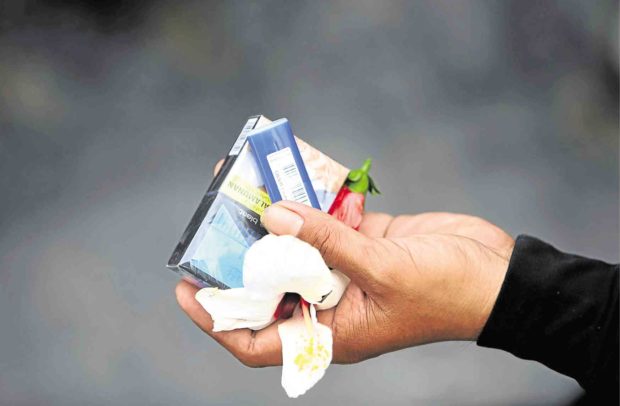
Flowers, cigarettes and a lighter are among the items placed inside the niche of Carl Angelo Arnaiz who was laid to rest Tuesday. His father told the media his son’s only vice was smoking. —LYN RILLON
As Carl Angelo Arnaiz was laid to rest on Tuesday, the police officers who “intentionally killed” him should reflect on two things: The lessons they were imparting to their children and the kind of legacy they would be leaving behind to the country.
In his homily at Arnaiz’s funeral mass at Mater Dolorosa Parish church in Makati City, Fr. Norman Balboa challenged the teenager’s killers to think about what they did to the former University of the Philippines student.
“To those who killed him, what kind of legacy are you leaving behind? Is this what you will teach your children? Will they say, ‘This is what my father left behind to the nation?’” Balboa asked.
Last seen alive on Aug. 17 when he left their house in Cainta, Rizal to buy some food, the 19-year-old Arnaiz was found 11 days later by his parents in a morgue at Caloocan City.
The city’s police force, which has taken a lot of flak for the killing of another teenager, Kian Loyd delos Santos, in an alleged anticriminality operation, claimed that Arnaiz held up a taxi driver on Aug. 18.
They added that when they chased him, he fired at them with a .38-caliber pistol, leading to a shootout.
Earlier, an autopsy conducted by the Public Attorney’s Office (PAO) on Arnaiz’s body showed torture marks. He was also shot five times — thrice on the chest. PAO forensic expert Erwin Erfe said the injuries pointed to his “intentional killing.”
Mostly clad in white, at least a hundred of Arnaiz’s family and friends bid goodbye to the teenager whom they had always known as “simple, helpful and cheerful.”
In between tears, Arnaiz’s sister, Camille, thanked those who sympathized with their family and “believed that he [was] innocent.”
Balboa said in his homily that he understood the pain the Arnaizes were going through since his brother was also a victim of extrajudicial killing. He reminded them and the teenager’s friends to take comfort in the fact that he left them with fond memories.
Subdued procession
Unlike Delos Santos’ funeral last month, Arnaiz’s was a bit subdued with no known groups or personalities present. In attendance, however, were UP students led by UP student regent Shari Oliquino who held a lightning rally outside the church.
Oliquino said that the spate of police killings targeting the youth was proof that the orientation of the Philippine National Police was to “uphold the interest of the state and not of the youth and the people.”
She warned the Duterte administration that if nothing was done to address the matter, it would only intensify public outcry for the upholding of human rights and the rule of law.
Just before the funeral, the Arnaiz family gathered around the television in their house in Cainta, Rizal to watch the Senate investigation into his death.
When Chief Insp. Jocelyn Cruz of the Northern Police Crime Laboratory said she found no indication that the teenager had resisted arrest based on the injuries he sustained before he was killed, the family heaved a collective sigh of relief.
Vindicated
“I told you so. My grandson is not capable of such a thing,” said a teary-eyed Norma, Arnaiz’s 71-year-old grandmother.
But the feeling of vindication was short-lived as hours later, the family laid the teenager to rest in a small niche at Aliw Catholic Cemetery in Pateros City.
The crowd was small, consisting of around 100 people, mostly Arnaiz’s family and friends. Also present were personnel from the Department of Justice’s witness protection program as well as militant student groups which called for an end to the extrajudicial killings under President Duterte’s “fascist” regime.
“Even before they said all that, we already knew Gelo (Arnaiz’s nickname) was innocent,” said his 46-year-old aunt, Magnolia Marquez. “He was just a quiet boy, never got into any sort of trouble. He was the son I never had.”
Erika Canillo, Arnaiz’s oldest friend and childhood sweetheart, recalled him as being brilliant but humble. “He made reviewers for us so we could pass the entrance exams at Makati Science High School. When the results came out, he got the second highest score,” she said.
Both got into UP three years ago — Arnaiz majored in interior design while Canillo took up tourism. But Arnaiz dropped out during his first semester in college to deal with depression.
Still, Canillo did not believe Arnaiz was troubled enough to engage the police in a shootout. “Not once in the more than 10 years I knew him did he show signs of violence. He loved math, he loved playing computer games. But robbing a driver? That’s too much,” she said.
Oliquino, the UP student regent, said that like Delos Santos, Arnaiz was “also a victim of state-sponsored violence under the vicious war on drugs.”
Victim of police brutality
“Ultimately, their deaths fall under the fascist regime of the Duterte administration which endorses police brutality,” Oliquino added.
Meanwhile, Arnaiz’s family continued to call for justice and for the government to help them find the culprits in his death.
“We are just praying that somehow, all this will make sense. That someday, Carl’s death will not be remembered as just another statistic,” Marquez said.